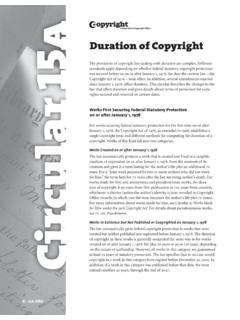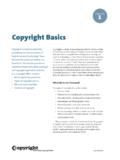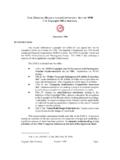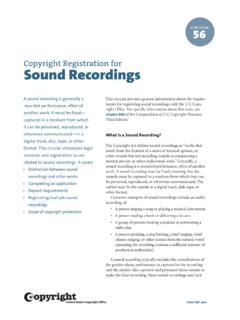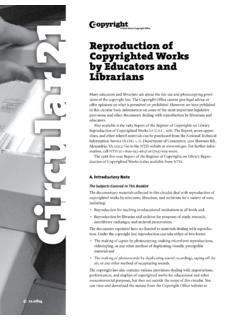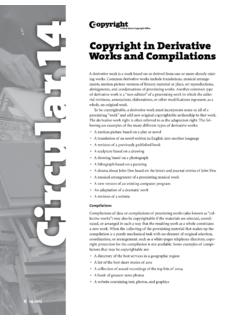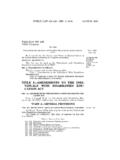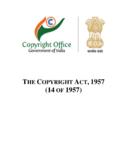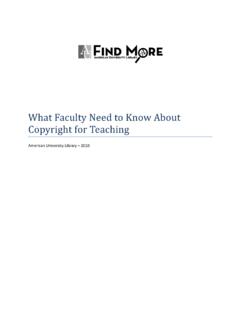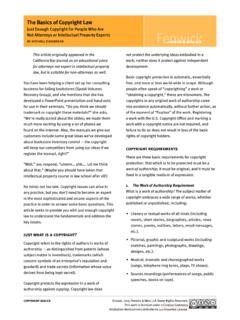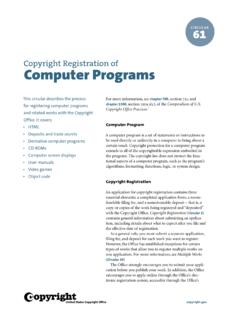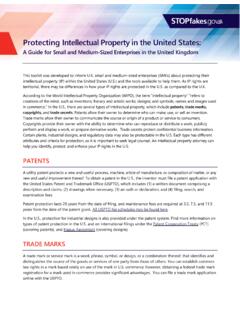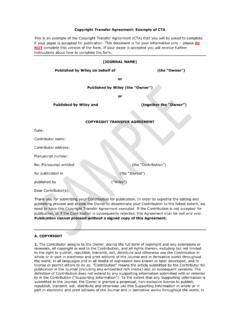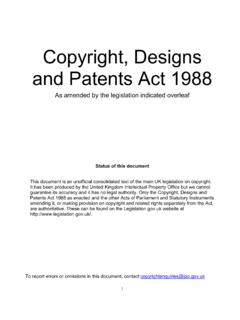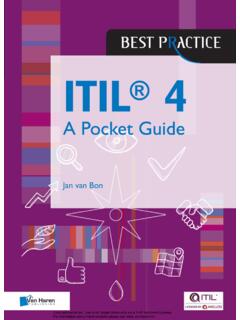Transcription of Circular 3 Copyright Notice
1 3 Copyright Notice is a statement placed on copies or phonore-cords of a work to inform the public that a Copyright owner is claiming ownership of A Notice consists of three ele-ments that generally appear as a single continuous statement: The Copyright symbol (or for phonorecords, the symbol ); the word Copyright ; or the abbreviation c o p r. ; The year of first publication of the work; and The name of the Copyright : 2017 John DoeThe use of a Copyright Notice is the responsibility of the Copyright owner and does not require permission from, or registration with, the Copyright Notice was required for all works first published before March 1, 1989, subject to some exceptions discussed below.
2 If the Notice was omitted or a mistake was made in using Copyright Notice , the work generally lost Copyright protection in the United States. Copyright Notice is optional for works published on or after March 1, 1989, unpublished works, and foreign works; however, there are legal benefits for including Notice on your Requiring NoticeDifferent laws govern works first published before January 1, 1978, and works first published between January 1, 1978, and February 28, 1989. The discussion in this Circular applies to works first published between January 1, 1978, and Febru-ary 28, 1989. For information about Notice for works first published before January 1, 1978, see chapter 2100 of the Compendium of Copyright Office Notice provides information to the public regarding Copyright ownership.
3 Notice is optional for works created after March 1, 1989, but is generally required for works created before that date. This Circular introduces the concept of It covers The elements of Notice Where Notice is required and where it is optional The legal formalities of Notice when it is required The advantages of including Notice on a workCopyright NoticeCopyright Notice2 Copies That Must Display NoticeIn general, for works first published before March 1, 1989, the Copyright owner was required to place an effective Notice on all publicly distributed visually perceptible copies. A visually perceptible copy is one that can be seen or read, either directly or with the aid of a machine.
4 Examples of visually per-ceptible copies include a book, sheet music, a photograph, or film. A visually perceptible copy does not include a CD, a vinyl record, or an .MP3 recording of a literary, dramatic, or musical a Copyright owner published a phonorecord that embodied a sound recording, an effective Notice had to appear on all publicly distributed phonorecords. The phonorecord symbol was needed only for publicly distributed copies of a sound recording embodied in a of NoticeAn effective Notice includes three general elements, as described above, as a single continuous state-ment. It was permissible to omit the year of publication for works reproduced on greeting cards, postcards, stationary, jewelry, dolls, toys, or any useful article.
5 See the following sections of chapter 2200 of the Compendium for specific issues regarding the elements of Notice : Section for variations on the or symbol, or the word Copyright Section for variations on the year of publication Section for variations on the name of the Copyright ownerPlacement of NoticeThe Copyright Notice had to be placed on copies or phonorecords in a way that was permanently legible to an ordinary user of the work and could not be concealed from view upon reasonable examination. The Office adopted specific regulations for the placement of Notice on the following types of works: Literary works Contributions to collective works Musical works Sound recordings Dramatic works Motion pictures and other audiovisual works Pictorial, graphic, and sculptural works Multipart works Works published in machine-readable copiesFor more information, see chapter 2200, section 2207, of the of Notice and Errors of NoticeAn omission or mistake in using a Copyright Notice may not have invalidated the Copyright to works published between January 1, 1978 and March 1, 1989, if The Notice was omitted from no more than a relatively small number of copies or phonore-cords distributed to the public.
6 Copyright Notice3 The work was registered before or within five years after the publication without Notice and a reasonable effort was made to add Notice to all copies or phonorecords distributed in the United States after the omission was discovered; The omission violated an express written agreement to include proper Notice as a condition of public distribution of copies or phonorecords; or, The Notice was removed from the copies or phonorecords without the authorization of the Copyright Notice Is OptionalCopyright Notice is optional for unpublished works, foreign works, or works published on or after March 1, 1989. When Notice is optional, Copyright owners can use any form of Notice they wish.
7 How-ever, works first published after March 1, 1989, may need to comply with statutory formalities to pre-vent a defendant from invoking an innocent infringement defense in a Copyright infringement WorksA Copyright Notice has never been required for unpublished works. The Copyright Office will register an unpublished work that does not bear a Notice , regardless of whether the work was cre-ated before or after March 1, 1989. Nonetheless, because the dividing line between a preliminary distribution and actual publication is sometimes difficult to determine, Copyright owners may want to place Copyright notices on copies or phonorecords that leave their control to indicate that rights are claimed in a work.
8 For example, an appropriate Notice for an unpublished work is Unpublished Letters of John Doe 2017 John Doe, where 2017 refers to the year the work was Works and the Uruguay Round Agreements ActFor certain foreign works, the Uruguay Round Agreements Act (URAA) of 1994 modifies the effect of publication without Notice . The URAA restored copyrights for foreign works that lost Copyright protection in the United States for failure to comply with Notice requirements prior to March 1, 1989. They include (a) works created by an author who, at the time of the work s creation, was a citizen of, or domiciled in, a country that had entered into a Copyright treaty with the United States, and (b) works first published, or sound recordings first fixed, in a country that had entered into a Copyright treaty with the United States.
9 Although restoration is automatic in eligible works, the URAA directs the owner of a restored work to notify reliance parties if the owner plans to enforce his or her rights in the For more information, see Copyright Restoration Under the URAA ( Circular 38B).Advantages to Using a Copyright NoticeAlthough Notice is optional for unpublished works, foreign works, or works published on or after March 1, 1989, using a Copyright Notice carries the following benefits: Notice makes potential users aware that Copyright is claimed in the work. In the case of a published work, a Notice may prevent a defendant in a Copyright infringement action from attempting to limit his or her liability for damages or injunctive relief based on an innocent infringement Notice4 Notice identifies the Copyright owner at the time the work was first published for parties seek-ing permission to use the work.
10 Notice identifies the year of first publication, which may be used to determine the term of Copyright protection in the case of an anonymous work, a pseudonymous work, or a work made for hire. Notice may prevent the work from becoming an orphan work by identifying the Copyright owner and specifying the term of the Copyright . Copyright Notice5notes1. This Circular is intended as an overview of the basic concepts of Copyright Notice . The authoritative source for Copyright law is the Copyright Act, codified in Title 17 of the United States Code. Copy-right Office regulations are codified in Title 37 of the Code of Federal Regulations. Copyright Office practices and procedures are summarized in the third edition of the Compendium of Copyright Office Practices, cited as the Compendium.
